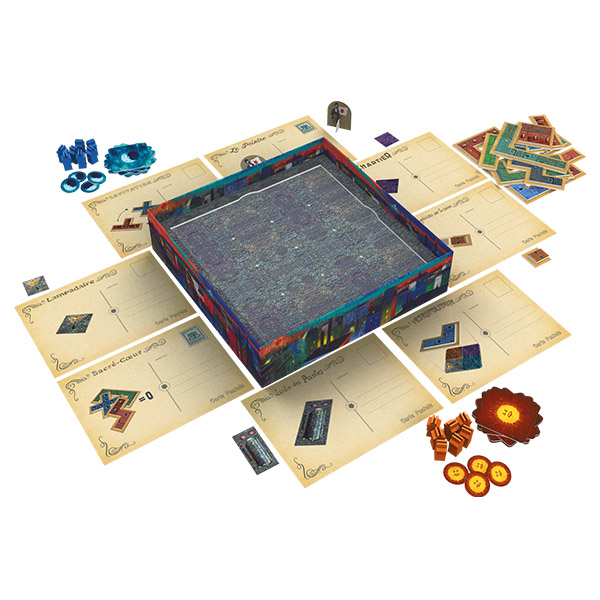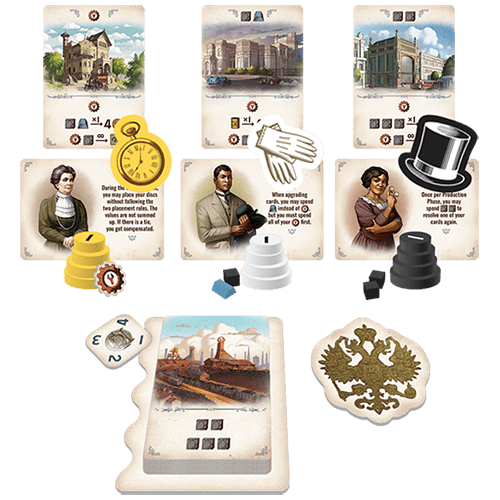Richard Garfield created two of the best-known properties in tabletop gaming – Magic: the Gathering, the original collectible card game and the most popular deckbuilding game ever; and King of Tokyo, a dice-rolling, push-your-luck game that I think is fantastic for family game nights. Now he’s joined the roll-and-write craze with Dungeons, Dice, and Danger, which takes the format and marries it to that classic of role playing games, the dungeon crawl.
Dungeons, Dice, and Danger comes with five dice, four white and one black. On each player’s turn, they’ll roll all five dice and then must create two pairs from the five to mark off two spaces on their scoresheets, which show one of four different dungeons. The scoresheets have maps, with a number in each regular room space, and some spaces that show monsters and have one or more numbers and various boxes to fill. You can only check off a box adjacent to one you’ve already marked, or one of the green start boxes around the edges of the map. The other players may also mark off rooms, but they only get to use the white dice to form those pairs, unless they use one of their three special black die markers to use the black one on that particular turn.
Monsters require multiple turns to defeat; you must roll any of the numbers shown in the monster’s room, and then mark off one small box in that room each time you get a matching number. Once you’ve filled in all of the boxes, you’ve killed the beast, earning several gems (marked on a track at the bottom of the page), and may proceed to any rooms through that one. Some monsters show numbers that are only outlined; you have to visit the adjoining room with that number to ‘activate’ that number in the monster’s room, allowing you to use that roll to deal damage to the monster.
The first player to defeat a monster gets 2-3 gems as a reward; subsequent players will still get one. Every player can also gain a gem by marking off any room with a gem in it, and can gain 3 gems by completing either of the two objectives in the lower left of the scoresheet, which vary by map. At game end, you get three points per gem, and on maps with gold in certain rooms, you get two points per gold pile marked.
There are also two treasure rooms on each map, and when you mark one of those rooms, you get to choose one of the three special benefits on the right side of the map. You can get three extra black die spaces for the rest of the game; you can absorb three damage points without marking the spaces on your health track; or you can mark off two rooms adjacent to ones you’ve already visited. There are also spaces where you just have to have two matching numbers on the dice, but it can be any pair, which isn’t explained in the rulebook.
There’s a catch, however: As in dungeon crawl games, you can ‘die’ in DD&D. If you can’t mark off two rooms or squares on any turn, you lose one health point for each dice pair you couldn’t use. There are ten spaces in the health track, and if you lose all ten, you’re out of the game. There’s also a points penalty after the first two lost health points, going up to 20 points off in the last space. You can also lose health points for being the first person to defeat the big foozle on each map, usually two boxes checked, although you get up to 6 gems for the achievement.

There’s also a solo mode, as in most roll-and-write games. Here, you are always the “passive” player – you can never use the black die without marking off one of those spaces on the right side of your sheet. You always get the maximum reward for defeating a monster, and always take the damage when you beat the biggest one on a map. You can avoid the damage from failing to use one pair of dice if you used the other pair to deal damage to a monster.
There’s some strategy to DD&D, because you’re trying to set yourself up to have as many possibilities as you can for the next roll. There aren’t that many 7s on any map, and not enough 6s and 8s. Mapping out future moves is the one bit of control you can have in the game … but ultimately, I think there’s too much randomness. Planning only gets you so far when the maps are drawn in such a way that as the game nears its end, you’re going to have only a few options available to you, and you don’t have any way to alter the dice. That’s not to say that the game is too difficult; I played all four of the maps, solo, and scored 90+ on three of them, topping out at 111 on the third map, all of which put me in the top two tiers in the scoring guide. I busted completely on the fourth one, which I think requires a fair bit of luck on the dice to complete, and busted at the very end of the second one, still scoring in the 90s because I defeated every monster but the last one. In most turns, though, I had one valid choice. There was just a single set of pairs that would both mark off rooms or boxes on my scoresheet without requiring me to take damage. The result was that the game felt rote, rather than one where I was in reasonable control of things. I love roll-and-writes, and I could see why someone might love this, especially with a theme I haven’t seen in the genre before, but this was just below the bar for me, a C+ game rather than a B-.









